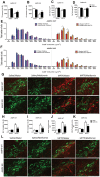Metformin Prevents Nigrostriatal Dopamine Degeneration Independent of AMPK Activation in Dopamine Neurons
- PMID: 27467571
- PMCID: PMC4965122
- DOI: 10.1371/journal.pone.0159381
Metformin Prevents Nigrostriatal Dopamine Degeneration Independent of AMPK Activation in Dopamine Neurons
Abstract
Metformin is a widely prescribed drug used to treat type-2 diabetes, although recent studies show it has wide ranging effects to treat other diseases. Animal and retrospective human studies indicate that Metformin treatment is neuroprotective in Parkinson's Disease (PD), although the neuroprotective mechanism is unknown, numerous studies suggest the beneficial effects on glucose homeostasis may be through AMPK activation. In this study we tested whether or not AMPK activation in dopamine neurons was required for the neuroprotective effects of Metformin in PD. We generated transgenic mice in which AMPK activity in dopamine neurons was ablated by removing AMPK beta 1 and beta 2 subunits from dopamine transporter expressing neurons. These AMPK WT and KO mice were then chronically exposed to Metformin in the drinking water then exposed to MPTP, the mouse model of PD. Chronic Metformin treatment significantly attenuated the MPTP-induced loss of Tyrosine Hydroxylase (TH) neuronal number and volume and TH protein concentration in the nigrostriatal pathway. Additionally, Metformin treatment prevented the MPTP-induced elevation of the DOPAC:DA ratio regardless of genotype. Metformin also prevented MPTP induced gliosis in the Substantia Nigra. These neuroprotective actions were independent of genotype and occurred in both AMPK WT and AMPK KO mice. Overall, our studies suggest that Metformin's neuroprotective effects are not due to AMPK activation in dopaminergic neurons and that more research is required to determine how metformin acts to restrict the development of PD.
Conflict of interest statement
Figures



References
-
- Hu G, Jousilahti P, Bidel S, Antikainen R, Tuomilehto J. Type 2 diabetes and the risk of Parkinson's disease. Diabetes Care. 2007;30(4):842–7. . - PubMed
-
- Sandyk R. The relationship between diabetes mellitus and Parkinson's disease. The International journal of neuroscience. 1993;69(1–4):125–30. Epub 1993/03/01. . - PubMed
MeSH terms
Substances
Grants and funding
LinkOut - more resources
Full Text Sources
Other Literature Sources
Medical
Molecular Biology Databases
Research Materials

